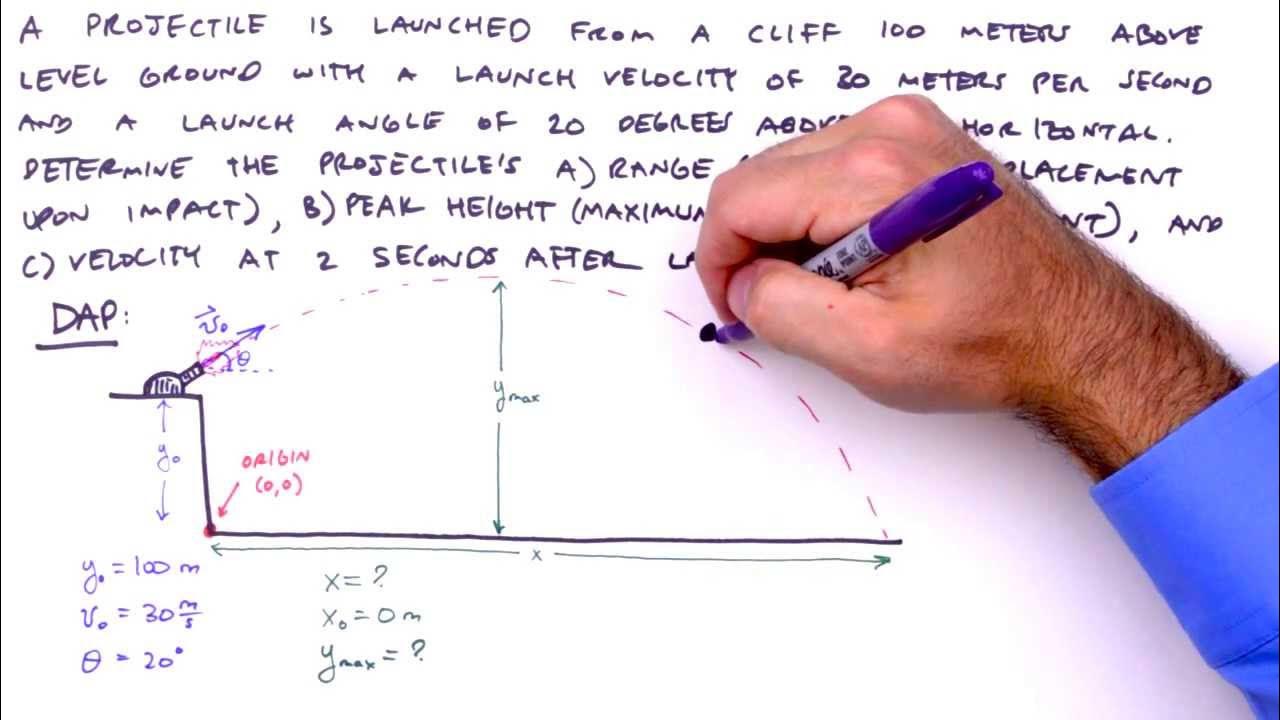12-88 | Engineering Dynamics Hibbeler 14th Edition | Engineers Academy
Summary
TLDRIn this video, the presenter explains how to solve a projectile motion problem involving a basketball. The goal is to determine the ball's initial velocity and its velocity when it passes through the basket. Using coordinate systems, equations of motion, and projectile analysis, the presenter calculates the time it takes for the ball to reach the basket, the initial velocity, and the final velocity components. The final result includes the ball's velocity at point B (10.84 m/s) and the angle of trajectory (-20.67°), offering a clear breakdown of the problem-solving process in projectile motion.
Takeaways
- 😀 Define the coordinate system by placing the origin at the point where the ball is initially thrown.
- 😀 The initial velocity of the basketball (vₐ) has two components: horizontal (vₐₓ) and vertical (vₐᵧ), based on the launch angle (30°).
- 😀 The problem involves solving for the initial velocity (vₐ) and the final velocity at point B (vᵦ).
- 😀 Horizontal motion is governed by the equation x = x₀ + vₐₓ * t, where the horizontal component of velocity remains constant.
- 😀 Vertical motion is governed by the equation y = y₀ + vₐᵧ * t - (1/2) * g * t², where gravity accelerates the ball downward.
- 😀 The time it takes for the ball to reach point B is found by solving a quadratic equation for vertical motion.
- 😀 The time to reach point B is 0.987 seconds, which is derived from the vertical motion equation.
- 😀 The initial velocity (vₐ) is calculated to be 11.71 m/s using the time from the horizontal motion equation.
- 😀 The final vertical velocity at point B (vᵦᵧ) is -3.827 m/s, indicating downward motion at that point.
- 😀 The horizontal component of the velocity at point B (vₓᵦ) is constant and equal to 10.14 m/s.
- 😀 The magnitude of the final velocity at point B (vᵦ) is 10.84 m/s, found using the Pythagorean theorem from the horizontal and vertical components.
- 😀 The angle of the final velocity at point B (θᵦ) is -20.67°, indicating the direction measured clockwise from the positive x-axis.
Q & A
What is the main objective of the problem presented in the script?
-The main objective is to determine the initial velocity (va) of a basketball at point A and the velocity at point B when the ball passes through the basket.
Why is it important to define a coordinate system in projectile motion problems?
-Defining a coordinate system is essential because it helps to establish reference points for both the initial and final positions of the object, and allows for a systematic approach to solve the equations of motion.
What are the components of the initial velocity (va) at point A?
-The initial velocity (va) at point A has two components: one acting along the x-axis (vax) and one acting along the y-axis (vay). These components are calculated as vax = va * cos(30°) and vay = va * sin(30°).
What are the coordinates of point B in the problem?
-The coordinates of point B are 10 meters along the x-axis and 1 meter along the y-axis (from the origin).
How is the horizontal motion equation used to find the time (t)?
-The horizontal motion equation is used to relate the initial position, velocity components, and time. It is expressed as x = vax * t, and since we know the distance (10 meters) and the component of velocity along the x-axis (vax), we can solve for the time (t).
How is the vertical motion equation used in this problem?
-The vertical motion equation relates the final vertical position (y), the initial velocity in the vertical direction (vay), time (t), and gravitational acceleration (g). It is written as y = vay * t - 0.5 * g * t^2, and we use it to solve for time (t) and other unknowns.
What is the value of time (t) taken by the basketball to reach point B?
-The time taken by the basketball to reach point B is approximately 0.987 seconds.
How is the initial velocity (va) calculated once time (t) is known?
-Once time (t) is determined, the initial velocity (va) can be calculated using the horizontal motion equation, vax * t = 10 meters. Thus, va = 11.71 meters per second.
How are the velocity components at point B (vbx and vby) found?
-The horizontal component of the velocity at point B (vbx) remains constant and is equal to the horizontal component at point A (vax). The vertical component of the velocity at point B (vby) is calculated using the equation vby = vay - g * t, where g is the acceleration due to gravity.
How is the magnitude of the velocity at point B (vb) calculated?
-The magnitude of the velocity at point B (vb) is found by combining the horizontal and vertical velocity components at point B using the Pythagorean theorem: vb = sqrt(vbx^2 + vby^2).
Outlines

This section is available to paid users only. Please upgrade to access this part.
Upgrade NowMindmap

This section is available to paid users only. Please upgrade to access this part.
Upgrade NowKeywords

This section is available to paid users only. Please upgrade to access this part.
Upgrade NowHighlights

This section is available to paid users only. Please upgrade to access this part.
Upgrade NowTranscripts

This section is available to paid users only. Please upgrade to access this part.
Upgrade NowBrowse More Related Video

projectile motion explained

Gerak Parabola - Fisika Kelas 10 (Quipper Video)

How To Solve Any Projectile Motion Problem (The Toolbox Method)

Projectile Motion Lecture Part 2

Kinematics: Projectile motion | STPM Physics

FISICA (CLASE 46) - MOVIMIENTO parabólico O MOVIMIENTO de proyectiles - MOVIMIENTO EN EL PLANO
5.0 / 5 (0 votes)